Equipment Insight: Wheel Loaders
Industry experts share how advances in wheel loaders are changing the way these units fit into today’s rental centers.
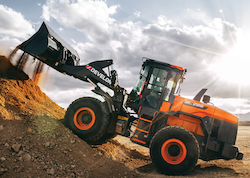 |
|
The new -7 Series Develon wheel loaders now come standard with Develon’s Transparent Bucket technology. |
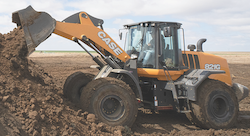 |
| From full-sized wheel loaders to the sub-compact articulated loaders, there’s a wheel loader for every type of customer. |
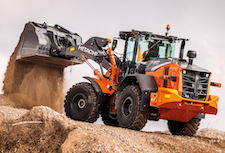 |
|
Hitachi’s Aerial Angle system provides all-around machine views on an 8-inch screen for additional situational awareness on busy work sites. |
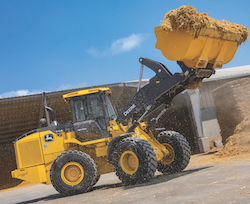 |
|
John Deere P-Tier and X-Tier wheel loaders have Auto Level technology designed to eliminate frequent bucket and fork adjustments. |
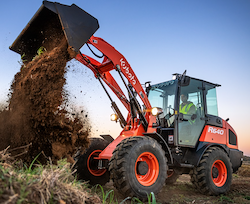 |
|
Kubota R Series wheel loaders have tie-down points located low on the frame for easy access. LED work lights are available across all R Series wheel loaders. |
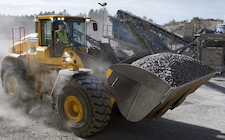 |
|
Volvo Load Assist’s onboard weighing helps operators and site managers know how much material has been moved. |
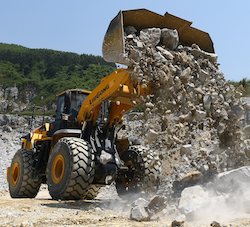 |
| The LiuGong 835Hv, 838Hv, 848Hv, 856Hv and 890Hv models offer significant performance enhancements and Stage V emission standard compliance. |
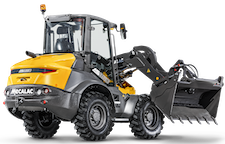 |
|
With four-wheel steering and a 180-degree swivel arm, the Mcalac AS series have a full turning radius footprint 20 percent smaller than a conventional wheel loader. With its unique swivel arm, cycle times are greatly reduced by allowing the loader to scoop, pivot and dump without moving the machine. |
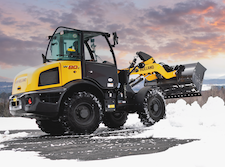 |
|
Compact wheel loaders come in a variety of frame sizes and horsepower ratings, so it’s essential to consider the types of customers that rental centers serve. |
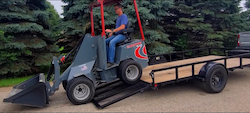 |
|
A subcompact wheel loader fits on a light-duty trailer due to its light weight and compact size. |
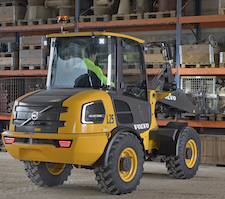 |
|
Electric machines can work indoors, near food or animals, in urban areas at night and more. As companies and governments set emissions goals or requirements, renting electric equipment is an easy way to reach them. |
IMPROVING WORKER SAFETY
 |
|
JACOB SHERMAN |
New wheel loader models feature technologies that enhance safety for the operator and workers on job sites. The new Develon-7 Series wheel loaders feature Develon’s Transparent Bucket technology. Two cameras combine video feeds that make the bucket appear transparent. They are also available with an around-view monitor (AVM) system for up to 270 degrees of visibility and an object detection. New floor-to-ceiling windows on the sides of the cab coupled with an around-view monitor and Transparent Bucket give operators great visibility.
The -7 Series models feature the Develon Smart Guidance System that gives operator tips to improve productivity. An optional Load Isolation System can reduce material loss from the bucket and enhance operator comfort.
Some considerations rental centers need to think about when adding new wheel loader models are related to safety and productivity. Wheel loader technologies such as Transparent Bucket technology, around-view monitor camera systems and object detection systems can improve job site safety.
Telematics continues to be an important topic in the rental industry and Develon wheel loaders come with a fleet management system that enables remote machine monitoring. If there’s an issue, the rental center and the equipment dealer can be notified for fast resolution.
Rental centers can increase demand or return on investment by offering a quick coupler and attachments. Develon offers a tool carrier design for everyday lift-and-carry applications. The DL200TC-7 and DL250TC-7 tool carriers are ideal for contractors wanting a smaller wheel loader with a pallet fork. The parallel lift linkage design of the tool carriers gives operators good visibility to the attachment and object being carried.
 |
|
BRAD STEMPER |
NEW WHEEL LOADER MODELS FIT EVERY CUSTOMER TYPE
From full-sized wheel loaders to the sub-compact articulated loaders, there’s a wheel loader for every type of customer. Things we’re seeing in wheel loaders:
Electrification: Some segments of the market are ideally suited for electrification, particularly in compact and sub-compact models that can be charged overnight. These machines are ideally suited for rental businesses that serve contractors who work indoors on commercial building renovation/reconstruction or work in locations that are incentivized to use electric equipment.
Semi-automation of machine actions: Return to Dig, Return to Travel and Height Control functions can help operator performance and confidence.
Simplified controls: Electro-hydraulic control technology keeps getting better, delivering more ways operators can dial in performance to tasks and job types.
Integrated payload: Some full-sized wheel loaders feature integrated payload systems, which help rental customers track load information, more effectively and accurately load trucks and add insight into machine performance and productivity. There has been a tendency against adding bells and whistles on rental units but may differentiate your wheel loaders from rental competitors.
Connected technologies: By performing remote diagnostics, remotely upload software and see deeper telematics data offers the owner, manufacturer and dealer deliver a better product and service.
Attachments: The rental business is all about utilization and the more ways a machine can be utilized, the more ways it can be rented. Do you have a coupler common to your small wheel loaders, skid steers and compact track loaders that optimizes attachment use?
Comfort and visibility: Wheel loaders provide a higher vantage point and a greater field of view from the operator’s seat than other types of equipment.
Many factors should be considered in new wheel loader selection but remember that utilization equals ROI. The more an asset is out on ren, the more profitable it will be. Further, service and maintenance costs can be managed with maintenance contracts and other plans.
Rental business owners should keep in mind the type of loaders that are in demand by the local market and be aware of all the ways they can increase utilization when they spec a new wheel loader.
For example, if you’re surrounded by five aggregate plants that could be crippled if a large wheel loader goes down, it may make sense to keep full-sized machines in your rental fleet. If you’re in an area that has many landscapers, then smaller loaders and compact wheel loaders may make more sense.
Consider equipment size and transportation requirements. Will it require you to get a larger truck or trailer that requires a CDL driver?
Nothing drives utilization more than attachments. Think of an attachment as an expansion of the services you offer customers, which makes you an even more valuable partner and they will return to you time and again.
Finally, consider ease of service. Wheel loaders that offer the most straight-forward service requirements will be the most popular with rental businesses.
 |
| Matt Koester Wheel Loader Product Manager Hitachi Construction Machinery Americas |
INCREASED EFFICIENCY, PRODUCTIVITY AND SAFETY FULFILL CUSTOMER NEEDS
Hitachi continues to offer new technologies such as payload weighing systems and approach-speed controls to ensure the highest levels of productivity while reducing fuel consumption.
Improving visibility through new technologies such as the Aerial Angle system that offers rear, left- and right-side machine views on a screen offers greater situational awareness on busy work sites.
Rental centers require machines to fulfill many operations and applications. Having models available that are equipped with quick couplers and auxiliary hydraulics ensure the wheel loaders are ready for many applications.
As the market becomes more technologically advanced, further demands from customers for productivity and efficiency require advances such as installed weighing systems and intelligent power management systems. Having models that can run attachments and are equipped for most operation requirements ensures the largest rental market potential, and models that provide longer times between major maintenance intervals can improve ROI. Tracking maintenance and using service and telematics programs such as Hitachi’s ConSite will provide more details on fleet performance, tracking hours and maintenance intervals.
 |
| Luke Gribble Solutions Marketing Manager John Deere |
JOB SITE SAFETY GROWS IN IMPORTANCE
The next generation of John Deere wheel loaders are designed to improve operator visibility and awareness. John Deere offers Advanced Vision Systems that integrate cameras on the side-view mirror frames for visibility to the sides of the machine. On the cab display, operators can get an integrated view of all cameras for enhanced clarity.
To increase accuracy and productivity, John Deere’s SmartWeigh system is available on John Deere P and X-Tier utility wheel loaders. It can help improve cycle times when loading trucks or tending processing plants. It helps operators hit load targets and cut material loss.
Also new to the P-Tier and X-Tier wheel loaders is Auto Level technology that can eliminate frequent bucket and fork adjustments. Operators do not have to worry about the load tipping too far as the bucket raises or lowers.
Rental centers thinking about bringing new wheel loader models into their rental fleet must prioritize time, versatility and quality. Machine quality is very important when companies have tight turnaround times. The machines should have the ability to run for longer periods even in harsh conditions. High-quality machines and proper routine maintenance will help limit maintenance downtime.
Customers are always looking for ways to increase efficiency and convenience on the job. Versatile machines that are compatible with many attachments are an attractive option for any operator.
Rental centers can increase demand by making sure the equipment is configured to meet the needs of the market. Understanding the requirements of the local customer base, and then assembling a rental fleet based upon those needs will return the highest yield.
 |
|
Bill Holton |
USERS LOOKING FOR SIMPLER MAINTENANCE
The Kubota R430 wheel loader offers the operator or service technician convenient access to all key maintenance points. For example, a fuel level buzzer sounds during refueling to prevent overfilling and potential hazards from fuel spills. This can save the rental customer money with less fuel spillage.
The Kubota R540 and R640 models are powered by a direct-injection engine equipped with a Common Rail System (CRS) and Diesel Particulate Filter (DPF) which reduces maintenance by increasing the service intervals.
All Kubota R Series wheel loaders have tie-down points located low on the frame for easy access. LED worklights are available on all R Series wheel loaders and the R430 has a backhoe option for the ROPS model. With suspension seating, backlit digital displays, enclosed cabs and ROPS canopies mounted on sound and vibration isolating rubber pads, Kubota wheel loaders are designed to provide the operator a stress-free environment.
Kubota’s R Series wheel loaders come in open canopy (ROPS) or enclosed cab models. The canopy model offers rental houses a worry-free operator station and no broken doors or windows. The enclosed cab offers full climate control.
The R430 offers quick and convenient access to all key maintenance points, reducing downtime and maintenance costs. The engine bonnet opens for access to all main service areas; side panels provide speedy access to the fuel refill on the right side and battery on the left side.
 |
| Mike Zhou Product Manager, Wheel Loaders LiuGong North America |
NEW TECHNOLOGY IN NEW MODELS
The LiuGong wheel loaders line has advanced from the H series to the newer Hv series of models. The LiuGong 835Hv, 838Hv, 848Hv, 856Hv and 890Hv models offer performance enhancements and Stage V emission standard compliance. The 835Hv and 838Hv models feature the Cummins B4.5 engine with enhanced power and aftermarket services and transmission improvements that enhance traction force. The largest wheel loader in the North American market, the 890Hv, has emission upgrades, counterweight changes and steering improvements. Other items incorporated into these new models include:
- Counterweight changes that improve rear view, increase tipping load and improve departure angle.
- Hydraulics with impressive breakout force, lifting and cycling speed.
- Operator-focused cabs for the highest levels of safety, visibility and comfort.
The first commercially available battery electric wheel loader, the 856H-E MAX is available from LiuGong. It has been tested over several years and today, more than 2,000 models have been in applications around the world. It is quieter, more cost-effective over time and better for the environment. The machine is suited to applications in reduced noise surroundings or where charging is available. With run times of 10 hours for light applications and eight hours for heavy applications, a fast-charging option charges in 90 minutes.
Rental centers need to consider tried-and-true wheel loaders that are easy to maintain. Machines with easily accessible service points makes service or repair easier and readily available parts is key.
One of the other considerations rental centers need to think about is the warranty provided by the manufacturer. Having industry-leading warranties can help ensure the machines are going to run strong for the life of rental.
Some markets for LiuGong are primarily rent-to-own, where customers will rent machines first before shifting into ownership. With rent-to-own models, it’s important that the first machine is a great rental experience. It will help customers want to rent more in the future either for themselves or suggest renting to others.
 |
|
Peter Bigwood |
RETHINK THE JOB FOR BETTER SOLUTIONS
Mecalac’s approach to equipment design is different than other brands. Most manufacturers look at machines and consider how they can enhance the design. Mecalac engineers don’t just look at the machine; they look at the job site. That’s led to the development of the Mecalac swing loader line.
The Mecalac AS750 compact swing loader is the latest model that is changing how contractors think about loaders. With four-wheel steering and a 180-degree swivel arm, the AS series has a full turning radius 20 percent smaller than a conventional wheel loader. With its unique swivel arm, cycle times are greatly reduced by allowing the loader to scoop, pivot and dump without moving the machine. It prevents closing multiple lanes of traffic, which adds up to time, space and fuel savings.
Rental centers are focused on return on investment, and while price is a factor, the most innovative products typically carry a higher price tag. However, the higher investment might also warrant a greater return in overall productivity, increased utilization and lower maintenance and transportation costs.
These units increase productivity and may be able to demand higher rental rates and increased utilization while enhancing safety. With fewer skilled operators, offering a safe, easy-to-use machine is critical. The AS series units are stable in any terrain and once the rear axle is locked, the bucket can turn 180 degrees.
To increase rental demand, rental centers need to drive awareness of new product offerings as well as the features and benefits of those machines. Mecalac swing loaders provide revolutionary advantages over other loader options and have the potential to provide a unique solution.
If the rental sales team approaches the customer with vision and sees what they need instead of what they might ask for, there is huge potential to become a trusted partner for professional contractors and to differentiate a rental center with the innovative products it offers.
 |
|
Ryan Anderson |
MATCH UNITS TO CUSTOMER DEMAND AND NEEDS
Electric powered vehicles are entering the market and New Holland is planning to introduce the W40X, its first electric-powered compact wheel loader in 2024.
Electrified compact wheel loaders have much lower maintenance costs due to not having a combustion engine and fewer moving parts. They are easy to start, operate and charge. They are easy to service and have no disadvantpower and performance.
Electrified compact wheel loaders will be an ideal product for rental centers that serve DIYers and landscapers/contractors that need a machine with low noise and no air pollution.
New Holland Construction is introducing changes to the C-Series compact wheel loaders, including a new panel that simplifies the control layout. Other new features include:
- Automated boom control that lets the operator set return to dig, return to travel and height control from the cab.
- An easier to use Creep mode.
- Joystick-adjusted cruise control.
- Smart mode that reduces fuel use and road noise during travel/operation.
- A 7-inch LCD monitor that displays machine vitals and warnings.
- Encoder knob for screen navigation.
Compact wheel loaders come in a variety of frame sizes and horsepower ratings, so it’s essential to consider the types of customers that rental centers serve. If the area has regular snowfall and there are several large snow removal jobs, a larger frame compact wheel loader such as the W70C and W80C models that have 74 horsepower. On the other hand, if the market is more residential with many subdivisions needing snow removal or landscaping services, lower horsepower models such as the W50C or new W60C units may be a better fit.
Ergonomics and operating ease are also important to operator of all skill levels; properly outfitting and configuring a machine affects its versatility and resale value. Certain options should be considered when buying equipment, such as cabs with heat and air conditioning and quick-attach couplers for switching attachments. A variety of attachments, such as buckets, forks, plows, snow blowers and mowers in the rental yard is paramount to increasing demand and return on investment.
 |
|
Eric Yeomans |
LEVERAGE TECHNOLOGY TO GAIN CUSTOMER SATISFACTION
Volvo CE recently launched an upgraded version of its flagship loader, the L350H. It features a more responsive hydraulics system, new lift and tilt cylinders and increased hydraulic working pressure. The upgraded driveline has Volvo’s OptiShift that integrates Reverse by Braking and a lock-up function that can boost fuel efficiency by up to 15 percent and an optimized gear shifting ratio and a new converter offers up to 22 percent more tractive force.
Advances in software and other technology can help rental centers reduce equipment wear and tear and can increase customer productivity. Volvo Load Assist’s onboard weighing helps operators and site managers know how much material has been moved.
Machine connectivity allows operators to see other operator’s locations so they can make real-time adjustments to reduce idle time and fuel consumption. It can also help a site manager determine whether the right size and number of units are on the job for top productivity.
Another technology under development is collision mitigation. Wheel loaders spend up to 50 percent of their time working in reverse and this automatic braking feature helps reduce the risk of collisions when working in reverse.
Renting provides contractors the chance to try before buying, and that’s a great way to ease into the sustainability transition. Offering electric wheel loaders or models that have been redesigned for improved fuel efficiency are important steps in that direction.
 |
|
Glen Parrett |
SMALL UNITS FIND A NICHE
The development of the subcompact articulating loader has less to do with technology or features and more to do with a product category moving to North America. It has proven to be a viable product that has created opportunities for rental companies, dealerships and end-users.
The incorporation of a teleboom design, ergonomic operator controls and advances in hydraulics that improve machine responsiveness, lift capacity and attachment performance are continuing to change these machines.
Subcompact articulating loaders offer solutions to many users. Arborists, hardscapers, landscapers, farmers, light construction, land management and snow removal can benefit from these units. They are an ideal fit for DIYers.
The equipment offers 360-degree view from the cab and clear visibility of the attachment. It is also user and turf friendly. The side entry feature of the cab design reduces the risks of approaching the cab from the front of the machine. It fits on a light-duty trailer and its all-steel body makes the unit more durable and well-suited meet the demands of renters.
Carrying a variety of attachments is a good idea because it increases the rental center’s likelihood of renting to more customers. The mini-universal attachment plate is compatible with a large variety of attachments.
The availability of parts is crucial because downtime can hurt rental center revenue. Considering the problematic supply chain and lengthy lead times the industry has experienced, it’s a good idea to verify the manufacturer or dealer has the stock to support the goods they sell.
 |
|
Lars Arnold |
ELECTRIC UNITS ON THE WAY
Painting an accurate picture of how electric equipment can affect ROI is critical. It can open new kinds of work for the renter and increase the rental house’s potential customer base.
Electric machines can work indoors, near food or animals, in urban areas at night and more. As companies and governments set emissions goals or requirements, renting electric equipment is an easy way to reach them.
Equipment powered by an electric motor provides instant torque, unlike the slight delay found with some diesel-powered equipment. Volvo electric machines have virtually the same specs as their diesel-powered counterparts.
Maintenance is simpler on an electric machine. DEF or other filters are not needed; essentially, the only supplies required are grease and hydraulic oil. Overall, the lifetime of battery-electric components should be equal to or better than that of the diesel engine. Customers will find they don’t truly use a machine for all eight hours of a shift and can get by on one overnight charge.
Rental houses should also see fewer hours put on electric machines. With diesel engines, operating time is defined by engine runtime and many of those hours are idling. Electric machines do not idle; so, 10,000 hours on a diesel machine may only equate to 6,000 or 7,000 hours on an electric machine. These saved hours lower operating costs, improve total cost of ownership and boost resale value.
This article originally appeared in the July-Augut 2023 issue of Pro Contractor Rentals magazine. ©2023 Urbain Communications LLC. all rights reserved.








